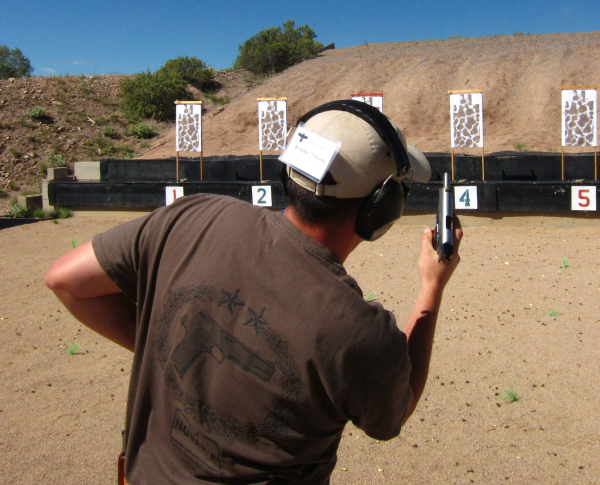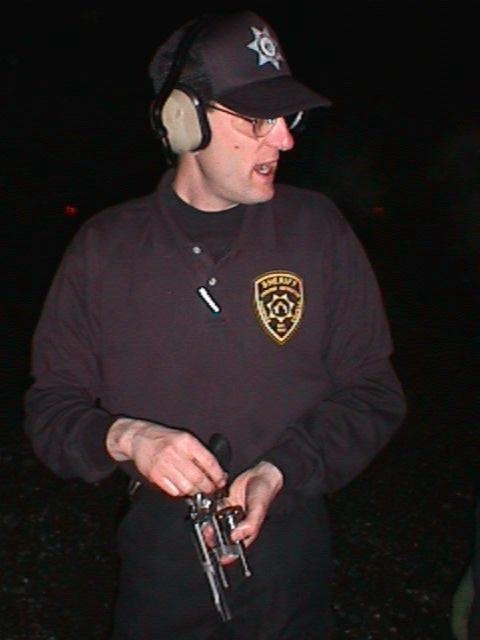In 2018, prompted by information from Kathy Jackson and Karl Rehn, I began to explore the execution of pistol loading consistent with Rule 2. I concluded that maintaining the safest available muzzle direction – knowing that we’re seldom on a firing range – was more critical than some perceived speed in refilling the gun.
I came across a source that had, coincidentally, arrived at the same conclusions. A bit of explanation is in order.

I’ve been a student in training classes where I was called out for failing to have the gun in my “work space” during reloads. The idea, it seems, is that you need to “see the magazine into the gun.” Coming as I did from an environment where refilling the duty handgun – in that era, a revolver – required the piece to be anchored to your center, muzzle down, while you kept your head up and actively looking for potential issues, the “work space” thing was foreign. I persevered.

After all, “when in Rome ….,” just do what you’re told. A nagging doubt involving the “universal” safety rules continued to bug me. And I found myself drawing the empty gun back toward my body – keeping it from the potential of grasping hands, among other problems, turning the (now-empty) magwell toward my center and the approaching full magazine, then dropping the slide with the muzzle slightly depressed – just like I’d done before.
… Largely without considering why I did it that way …
As the internet curmudgeon pointed out, even in a “workspace” reload, he caught people gazing down at the empty magazine well. The gun wasn’t raised high enough. When you’re rushed, you move the gun “close enough” to being picture perfect and push for speed.
Secondly, he points out – quite reasonably – that the available light doesn’t always allow a good “look the magazine into the gun” routine like it does on those beautiful sunny days on the range.
With the gun up and muzzle close to your face – he continues – you’re “serving it up” to any pair of hands that suddenly closed on your position, putting you in a great place for a gun grab attempt. Even if that doesn’t happen and you find yourself moving while you load, a fall feeds the gun right into your face.
It’s better to stay still while loading, but sometimes things happen.

He considers the “work space” to be better than the muzzle-up ready position because, in most scenarios that muzzle up or muzzle level ready is “range ready;” on the street, it’s “aggravated assault” ready. With the gun truly in that work space, the out-of-battery gun is pointed skyward. No need to keep it there to drop the slide.
He apparently prefers to bring the gun in and down, feeding the now-empty heater into the space being simultaneously occupied by the incoming magazine. A hasty glance down to confirm the union is a matter of small time and likely hurts nothing – as long as you don’t longingly gaze at the loading process and quickly get your head back up. He said that he “stole” this loading procedure from Kelly McCann.

I don’t recall seeing that, but I haven’t seen everything that he’s done.
When the gun is out of battery – in a condition in which it may not be fired – there’s some consideration that the muzzle may not always be in the best place. In my view, that’s best left for the ‘gravity-fed’ designs like revolvers of various types.
If you’re trying to unload a single action revolver, the muzzle will tend skyward when the loading gate is open (and/or when the piece is on half-cock). Likewise, the smart player will direct it muzzle down to feed in live rounds.
With a double-action swing-out revolver, the muzzle is still skyward for emptying the cylinder (it can’t fire with the cylinder outside the frame) and oriented down for loading (“Let gravity be your friend”).
With the bottom-feeding autoloader, you can direct and maintain a safer muzzle direction. It’s quickly enough loaded that a miscue can have the gun in-battery and the muzzle covering something you’d just as soon not shoot.
In any case, fighting for your life doesn’t absolve you from never allowing the muzzle to cover anything you’re not willing to destroy. It’s the rule that flows from Rule 1 (All guns are always loaded).
The technique proposed by our internet writer is something to consider and to try on the range – especially noting that Karl Rehn has already done the hard work in testing a similar technique.
— Rich Grassi